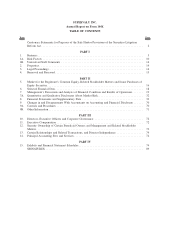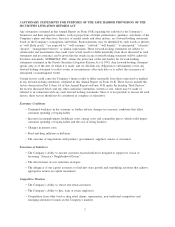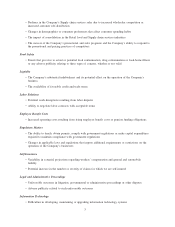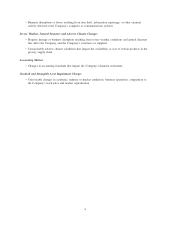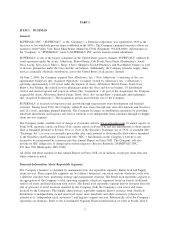Albertsons 2010 Annual Report Download - page 17
Download and view the complete annual report
Please find page 17 of the 2010 Albertsons annual report below. You can navigate through the pages in the report by either clicking on the pages listed below, or by using the keyword search tool below to find specific information within the annual report.with traditional grocery wholesalers on the basis of price, quality, assortment, schedule and reliability of
deliveries, service fees and distribution facility locations.
Competitive pressures on the Company’s Retail food and Supply chain services businesses may cause the
Company to experience: (i) reductions in the prices at which the Company is able to sell products at its retail
locations or to its independent retail customers, (ii) decreases in sales volume due to increased difficulty in
selling the Company’s products and (iii) difficulty in attracting and retaining customers. Any of these
outcomes may adversely affect the Company’s financial condition and results of operations.
Food and drug safety concerns and related unfavorable publicity
There is increasing governmental scrutiny and public awareness regarding food and drug safety. The Company
may be adversely affected if consumers lose confidence in the safety and quality of the Company’s food and
drug products. Any events that give rise to actual or potential food contamination, drug contamination or food-
borne illness may result in product liability claims and a loss of consumer confidence. In addition, adverse
publicity about these types of concerns whether valid or not, may discourage consumers from buying the
Company’s products or cause production and delivery disruptions, which may adversely affect the Company’s
financial condition and results of operations.
Substantial indebtedness
The Company has, and expects to continue to have, a substantial amount of debt. The Company’s substantial
indebtedness may increase the Company’s borrowing costs and decrease the Company’s business flexibility,
making it more vulnerable to adverse economic conditions. For example, high levels of debt could:
• require the Company to use a substantial portion of its cash flow from operations for the payment of
principal and interest on its indebtedness, thereby reducing the availability of cash flow to fund working
capital, capital expenditures, acquisitions, and other purposes;
• limit the Company’s ability to obtain, or increase the cost at which the Company is able to obtain
financing in order to refinance existing indebtedness and fund working capital, capital expenditures,
acquisitions and other purposes;
• limit the Company’s ability to adjust to changing business and market conditions placing the Company
at a competitive disadvantage relative to its competitors that have less debt; and
• Increase the Company’s risk of defaulting on debt obligations or breaching a covenant, which in turn
could result in cross defaults on other debt obligations.
Any of these outcomes may adversely affect the Company’s financial condition and results of operations.
Labor unions
As of February 27, 2010, the Company is a party to 235 collective bargaining agreements covering
approximately 106,000 of its employees, of which 71 covering approximately 12,000 employees are scheduled
to expire in fiscal 2011. These expiring agreements cover approximately 12 percent of the Company’s union-
affiliated employees. In addition, during fiscal 2010, 33 collective bargaining agreements covering approxi-
mately 29,000 employees expired without their terms being renegotiated. Negotiations are expected to continue
with the bargaining units representing the employees subject to those agreements. In future negotiations with
labor unions, the Company expects that, among other issues, rising healthcare, pension and employee benefit
costs will be important topics for negotiation. There can be no assurance that the Company will be able to
negotiate the terms of any expiring or expired agreement in a manner acceptable to the Company. Therefore,
potential work disruptions from labor disputes may disrupt the Company’s businesses and adversely affect the
Company’s financial condition and results of operations.
11


